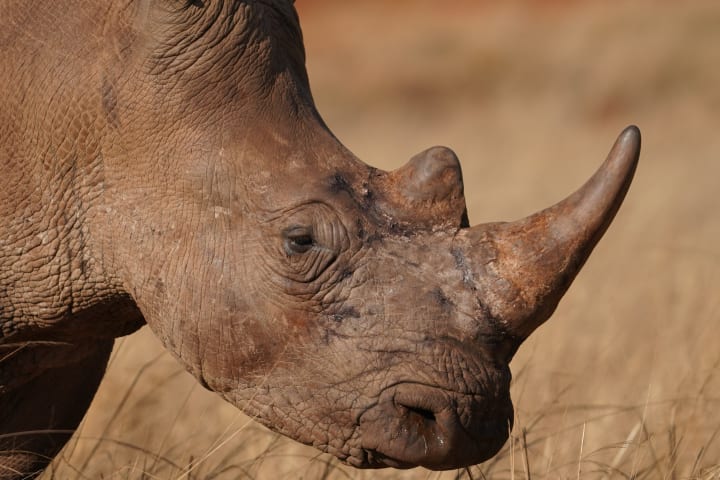Rhinos: Giants of the Savannah
A Glimpse into the Rhinoceros World

In the vast expanse of the African savannah, where the rhythm of nature beats in sync with the heartbeat of the Earth, one iconic creature stands as a symbol of strength, resilience, and the intricate balance of ecosystems—the rhinoceros. Rhinos, with their prehistoric appearance and majestic presence, are not only charismatic megafauna but also play a crucial role in maintaining the delicate equilibrium of their habitats.
There are five extant species of rhinoceros: the White Rhino , the Black Rhino, the Indian Rhino, the Javan Rhino, and the Sumatran Rhino. Each species has its unique characteristics, adaptations, and challenges, but all share a common thread of vulnerability in the face of human-induced threats.
Contrary to its name, the White Rhino is not actually white; it derives from the Dutch word "wijde," meaning wide, referring to the rhino's broad mouth. The White Rhino is the largest of all rhino species and is primarily found in grassland and savannah habitats. Its gentle nature and sociable behavior make it a captivating species to observe in the wild. Unfortunately, the White Rhino has faced relentless poaching pressure for its horns, threatening its survival.

The Black Rhino, with its hooked upper lip adapted for browsing on bushes and shrubs, is a more solitary and elusive species. Unlike the White Rhino, it prefers a solitary lifestyle and can be found in a variety of habitats, from savannahs to dense forests. Tragically, the Black Rhino has been a primary target for poachers seeking its valuable horn, driving the species to the brink of extinction.
In the floodplains and grasslands of India and Nepal resides the Indian Rhino, also known as the one-horned rhinoceros. This species is a conservation success story, with concerted efforts leading to population recoveries in protected areas. The Indian Rhino's armor-like skin and a single, sturdy horn add to its charismatic allure.
The Javan Rhino is perhaps the rarest and most elusive of all rhino species, with only a small population surviving in Java, Indonesia. Its solitary nature and preference for dense forest habitats make it a challenging species to study and conserve. Sadly, the Javan Rhino faces habitat loss and a constant threat from poaching.

As the smallest living rhino species, the Sumatran Rhino is a relic of ancient times. With its distinctive tufted ears and hairy body, this species is adapted to the dense rainforests of Sumatra and Borneo. Drastic habitat loss and poaching have pushed the Sumatran Rhino to the edge of extinction, prompting urgent conservation measures.
The rhinoceros's most distinctive feature, its horn, has been both a curse and a blessing. While these structures have evolved for various ecological purposes, including defense and mating rituals, they have become the primary reason for the rhinos' perilous situation. Rhino horns are highly sought after in traditional medicine and fetch exorbitant prices on the black market, driving ruthless poaching activities.

Conservationists and wildlife advocates have been tirelessly working to address the illegal wildlife trade, educate communities, and implement anti-poaching measures. Efforts to combat poaching include the dehorning of rhinos in managed reserves, a controversial but effective strategy aimed at reducing the financial incentives for poachers.
Beyond their charismatic appeal, rhinos play a pivotal role in shaping and maintaining ecosystems. As herbivores, rhinos are essential for controlling vegetation, preventing certain plant species from dominating and disrupting the balance of the food web. Their grazing and browsing activities create open spaces, influencing the distribution of plant species and providing habitat for a multitude of other organisms.
Rhinos also contribute to nutrient cycling through their dung, which serves as a fertilizer for plant growth. In turn, this benefits a diverse array of insects, birds, and other herbivores that depend on the health of the ecosystem. The decline of rhino populations could have cascading effects on the entire ecosystem, underscoring the importance of their conservation.

Despite facing numerous challenges, the conservation community has achieved significant successes in the battle to save rhinos. Dedicated conservation programs, community engagement, and the establishment of protected areas have contributed to the stabilization and recovery of some rhino populations.
In countries like Namibia and South Africa, community-based conservation initiatives have empowered local communities to become stewards of their natural heritage. By involving communities in wildlife management and providing economic incentives, these programs have created a harmonious relationship between humans and rhinos.
Additionally, advancements in technology, such as the use of drones and satellite tracking, have bolstered anti-poaching efforts. These tools enable conservationists to monitor rhino populations, detect poaching activities, and respond swiftly to potential threats.

The future of rhinos hangs in the delicate balance between human actions and conservation efforts. As we stand at the crossroads of history, it is imperative that we continue to support and expand conservation initiatives, strengthen anti-poaching measures, and address the root causes of illegal wildlife trade.
Public awareness and education are crucial components of this endeavor. By fostering a deeper understanding of the ecological importance of rhinos and the threats they face, we can inspire a global community committed to their survival. The extinction of rhinos would not only be a loss for biodiversity but also a stark reminder of our collective responsibility to safeguard the magnificent creatures that share our planet.
In conclusion, rhinos are not merely ancient relics; they are living sentinels of the wild, guardians of biodiversity, and ambassadors of the natural world. Their survival depends on our ability to rise above the challenges, transcend borders, and unite in the common goal of ensuring that these majestic creatures continue to roam the savannahs and forests for generations to come.
About the Creator
Scott Richards
Devoting my spare moments to crafting tales about animals. The beauty of nature brings me immense joy. If this resonates with you, consider subscribing to stay updated and never miss a story.
Enjoyed the story? Support the Creator.
Subscribe for free to receive all their stories in your feed. You could also pledge your support or give them a one-off tip, letting them know you appreciate their work.






Comments
There are no comments for this story
Be the first to respond and start the conversation.